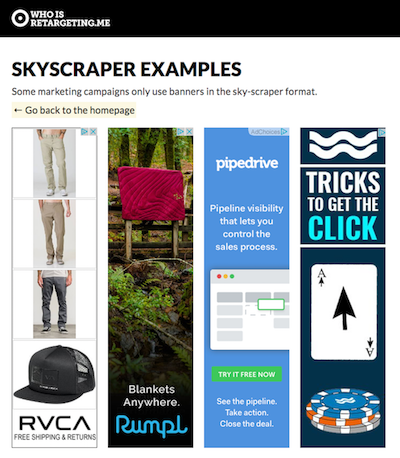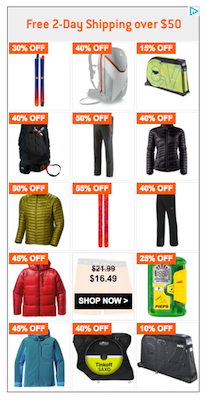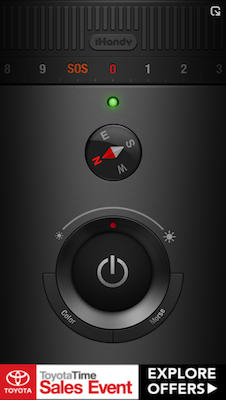What if every time you left a store empty-handed, a salesperson followed you to your car and listed off the items you almost bought? You didn’t leave with nothing because you weren’t interested. You left because you ran out of time, or maybe you wanted to do more research first.
Thankfully, retail sales people probably won’t chase you down in the parking lot. And they can’t easily track whatever it was that you carried around the store before leaving.
We always aim to steer clear of the digital equivalent of stalking site visitors. But we are able to track the visitors to our websites, as well as the items they almost purchased. So how do we use that information effectively, without overwhelming, or alienating potential customers?
As online marketers, we have a powerful tool at our disposal. Remarketing a.k.a “retargeting” is the practice of displaying banner ads to people after they’ve visited your site. It allows online retailers to track products their visitors weren’t quite ready to purchase, and display those items on other websites they visit. Remarketing can also be used to simply remind previous visitors of your brand with more subtle images and text.
Want to know which companies are currently remarketing to you? Visit www.whoisretargeting.me and you’ll see banner ads from sites you’ve visited. Some are relevant and tasteful, while others seem more like a digital version of that annoying store employee. Remarketing guarantees you’re delivering a message to people who are interested in your product. But with that power comes responsibility. The convenience of finding your potential customers around the web can become invasive or even offensive if you don’t take certain precautions with how you remarket. That doesn’t mean you should walk away from a strategy that, when carefully implemented, can generate significant online revenue.
Remarketing guarantees you’re delivering a message to people who are interested in your product. But with that power comes responsibility. The convenience of finding your potential customers around the web can become invasive or even offensive if you don’t take certain precautions with how you remarket. That doesn’t mean you should walk away from a strategy that, when carefully implemented, can generate significant online revenue.
Below, we highlight five of the biggest remarketing pitfalls along with steps you can take to avoid them and draw customers back, rather than driving them away.
1. Failing to exclude sensitive topics.
As a modern marketer, we have incredible insight into shopping patterns and online habits. But the Internet is still an enormous and complicated place, with a lot of context that we can’t control. Regardless of how powerful our remarketing abilities may be, the context with which we deliver our message to potential customers can present challenges.
When we leave the familiar space of our own website to remarket through other platforms, we’re entering a jungle of hot topics, heated conversations and sensitive territory. Consider the unfortunate placement above. Remington Firearms targeted the keyword “shooting” on YouTube, which wound up being displayed over a video of President Obama’s eulogy for nine shooting victims. This marketing blunder created unnecessary headaches for the PR team.
Consider the unfortunate placement above. Remington Firearms targeted the keyword “shooting” on YouTube, which wound up being displayed over a video of President Obama’s eulogy for nine shooting victims. This marketing blunder created unnecessary headaches for the PR team.
Thankfully, it’s a media disaster that we can avoid with foresight. You can exclude sensitive topics from remarketing with careful targeting. Brainstorm what kind of conversations would clash with your message. What keywords could lead your ads to the wrong place? What current social topics could be a touchy area for your brand? What political issues do you want to steer clear of? Take the time to ask these questions up front, and you’re much more likely to avoid a tricky situation when your campaign launches.
2. Displaying a cart full of items the customer may already own.

It’s just as important to track purchases as it is to track abandoned shopping carts. But avoid pushing the items they already have, and you’ll have a much better chance of luring them back to your site.
Proper audience segmentation will help you avoid this remarketing faux pas. Knowing the purchases they’ve already made will help you not only avoid the pointless effort of selling them something they have, but it will also help you cross-promote products they might not have noticed.
The ad on the left was served up a week after I had already purchased three of the items listed. If this advertiser had better audience segmentation in place, they could have focused their ad spend on promoting similar items rather than showing me products I already own.
3. Following your customer with their cart.
No one likes a creeper. It’s one thing to remind shoppers of your brand. It’s another situation entirely to stalk them with the information you’ve gathered.
Following your website visitors to other sites with the items they’ve previously selected on yours is pushy. It’s like calling someone immediately after a first date, as you drive alongside them in the next lane, waving with a silly smile on your face. Chances are that won’t get you a second date.
Instead of forcibly reminding customers of the items they almost purchased, which only serves to highlight how much information you’ve collected on them, try more subtle reminders of your brand instead. Make sure they don’t forget you, but don’t blast cheesy love songs from a stereo on their front lawn.
The following examples are subtle skyscraper banners that do a nice job of reminding customers of the brand, without aggressively pushing them to purchase anything.

4. Targeting customers on mobile apps.

When you open a mobile app, you have a specific reason to do so — that may be editing a photo, fumbling through the dark with a flashlight or sharing an article on social media. Nobody wants an ad taking over the screen and interrupting the task at hand.
Targeting customers on mobile apps will generally cause frustration. Do you really think someone who is fumbling for their keys in the dark is going to abandon their flashlight app to click your link? Probably not on purpose.
Google reports that about 50% of mobile ad clicks are accidental. Based on what we've seen, the "fat thumbs" effect is responsible for well over 60% of ad clicks and that figure is even higher on mobile app ad placements.
Screen sizes are getting bigger, but our phones were still designed to complete one task at a time in the limited amount of screen space our two thumbs control. Displaying ads on those small screens is like loudly inserting yourself into someone’s private conversation. Nobody likes that guy.
Stick to remarketing on larger screens — laptops, desktops, and tablets — where your message can stand politely to the side, attracting those who are genuinely interested rather than those fumbling in the dark. If mobile users are your target, focus on campaigns that place remarketing ads on search engines and websites rather than mobile apps.
5. Targeting again, and again … and again.
We all want our site visitors to remember us. But we want them to remember us for the right reasons — because they’re interested in what we offer and connect with our message.
Remarketing too much can irritate potential customers and leave them with a negative association to your brand. You work hard to create a brand image with positive connotations. You’re dependable, adventurous, inspiring, helpful — or whatever it is you aim to portray. You do not want to undermine those marketing and branding efforts by eliciting adjectives like pushy, intrusive, annoying or stalkerish.
When the SEO specialist site Moz.com first implemented remarketing, they went a little overboard, churning out banners to website visitors around the web. Customers were not pleased, and took to Twitter to complain about the onslaught of ads. This negative reaction on a public platform was a big headache, but they reacted fast and effectively revised their strategy.
Setting a frequency cap will help you avoid overwhelming potential customers. If someone has seen your ad a handful of times each day and hasn’t bothered to click, one more ad will probably just annoy them. We recommend a frequency cap of 3-5 per day, per user. More than that and you’re probably just wasting money while driving people nuts.
Remarketing is a valuable tool that online marketers should utilize to its greatest potential. Avoid these common mistakes, while keeping the customer experience at the forefront of your retargeting strategy, and you’ll see positive results.
Drop us a line to discuss your brand's remarketing






Share:
A New Breed of Agency Collaboration in Portland’s SE Waterfront
What Social Media Platforms Should Your Brand Focus On?